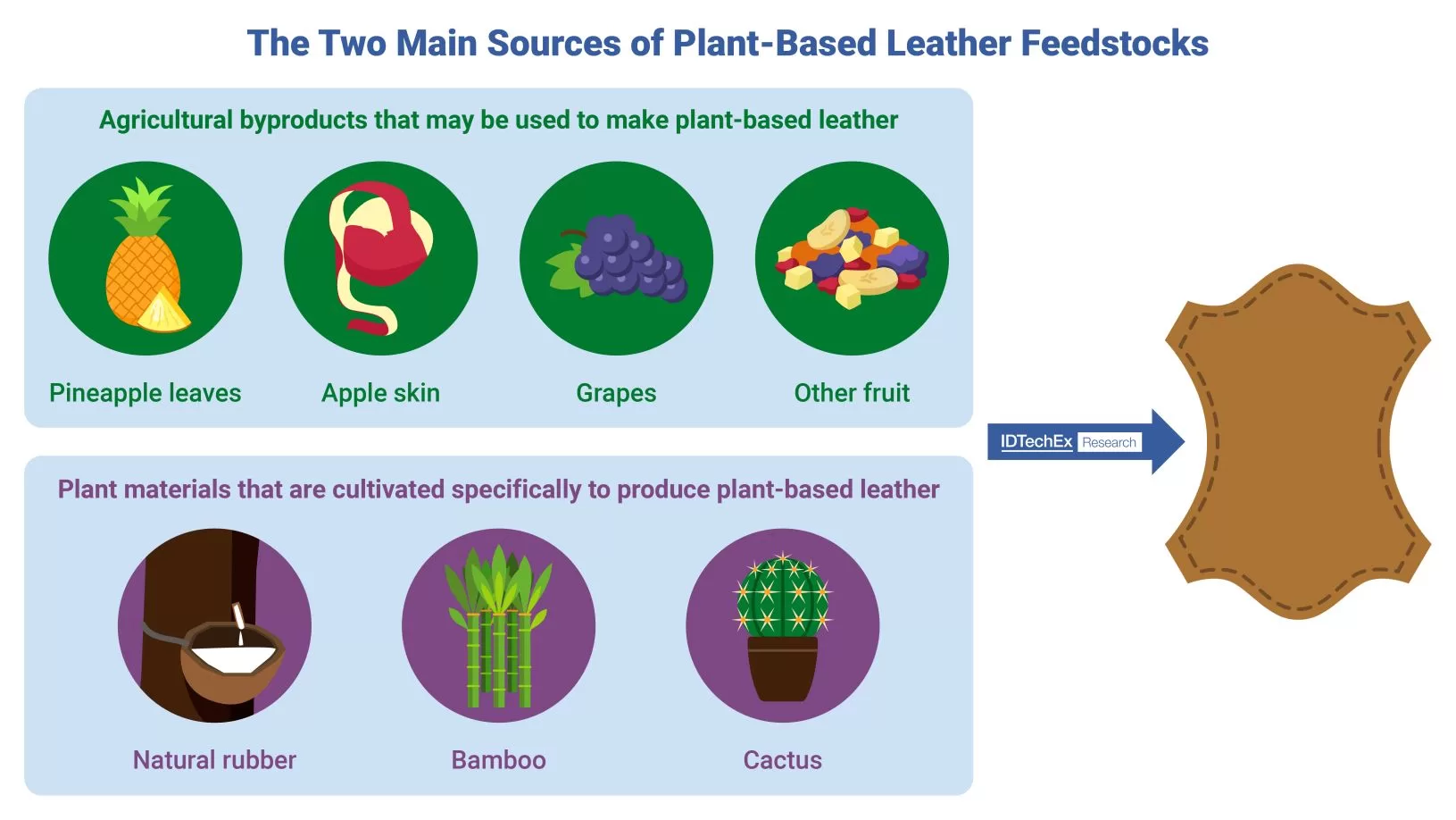Plant-based Leather: IDTechEx Discusses if It’s a Revolution in the Leather Industry

|
Author: James Kennedy, Technology Analyst at IDTechEx
Plant feedstocks are the biggest focus of companies entering the emerging alternative leather market. Companies are utilizing a very diverse selection of input feedstocks, including bamboo, grapes, apple skin, cactus, and pineapple leaves. Additionally, there are several different approaches to the incorporation of plant-based materials and the general manufacturing process.
The emergence of a wide field of competing feedstocks from different sources raises the question of which feedstock comes to dominate the field of plant-based leather and whether the feedstock would support the scale-up of the production of that plant-based leather. The question of whether these are mere eye-catching gimmicks or if these materials can be a serious competitor to the very well-established incumbent leather materials market must be answered.
Answers to this question with an extensive breakdown and analysis of commercial plant-based leathers, market players, and outlook alongside other competing alternative leather materials are available in IDTechEx’s market report, “Emerging Alternative Leathers 2024-2034: Technologies, Trends, Players”. |
|
|

|
A selection of the input feedstocks that are currently being utilized to produce plant-based leather. Source: IDTechEx |
||
|
Agricultural Byproducts:
Many plant-based leather producers are focusing on supporting a circular economy with their products. This is through utilizing the plant byproducts of another already established industry. Emerging alternative leather producers aim to capitalize on the opportunity to maximize sustainability by utilizing waste.
The choice of using this waste material, however, does place certain constraints on the alternative leather producers. By relying heavily on the output of another industry, the supply chain is more fragile. Not only this, but the quality of waste materials can vary, ultimately making quality control and consistency more difficult to achieve. Additional processing may also be necessary to improve purity, which can result in yield loss. While the feedstock price would be theoretically very low compared to other feedstock, which ultimately means the cost of the final material may be reduced, obtaining and transporting the waste feedstock may present new challenges.
Dedicated cultivation of crops:
A different approach to feedstock is that of dedicated cultivation. This involves growing plants specifically to produce leather or to buy market-ready plant materials for the same purpose. This method has several advantages, including higher-quality input feedstock and the ability to be more selective. This ultimately means that plant-based leather can be produced with greater consistency in quality. Additionally, the overall processing of the feedstock can often be simplified.
However, when it is necessary to invest in crop cultivation, new challenges can arise, including managing agriculture and other associated costs.
Theoretically, plant feedstocks have a low environmental impact, although this can vary as some crops require higher water and land usage. Whether utilizing by-products or crops grown for purpose, the process from plant material to leather alternative is a simpler process than that of competing technologies such as mycelium leather, microbial leather, and lab-grown leather. The relative accessibility of producing plant-based leather over these competing technologies most likely accounts for the disproportionate number of companies producing it.
Manufacturing methodologies
In addition to the two approaches to feedstock, there are also two main manufacturing approaches to processing the plant-based feedstock into a leather-like material: a bio-composite-based approach and a textile-based approach. Both are being utilized to varying extents by the nearly fifty market players producing plant-based leather.
Bio-composites:
The first approach is to create a bio-composite material. This involves the initial processing of plant matter and the formation of a bio-composite consisting of both plant and animal fibers. This results in a homogeneous material that is then formed into sheets. Finishing techniques, including dyeing and texturing, are then applied.
Textile approaches:
There is a textile-based method that closely follows the manufacturing process of plastic leather, where one or more of the components are replaced with a plant-based alternative. This can be the textile backing, the coating, or both. Plant fibers are initially processed to produce a pure selection of fibers; dyeing can occur here if necessary. These fibers are then processed in one of two ways. They are either formed into a mat or are formed into a yarn, which is subsequently woven into a textile. Coatings, either biobased or plastic-based, are then applied to this textile layer. A small number of companies have developed coatings that utilize biopolymers and exclude petroleum-based polymers.
The textile-based approach allows for greater utilization of existing manufacturing technologies. This is an important consideration as it can make scaling a more cost-effective process compared with scaling of other emerging alternative leather technologies and more innovative plant-based approaches. As such, most of the market-leading companies in plant-based leather are using this approach.
It is expected that as the emerging alternative leather market begins to expand and more companies enter the space, more feedstocks will be utilized, as is currently happening. In the long term, however, it is expected that certain feedstocks will prove to dominate the market. The most successful feedstocks and plant-based leathers will be those that can most successfully navigate not just scalability, durability, and suitability for key applications but also be cost-competitive. These factors will determine whether plant-based leather can create a revolution in the leather industry.
For further information on this market, including discussion on over 70 players, analysis of numerous vegan bio-based leathers, and a 10-year market forecast, see the market report, “Emerging Alternative Leathers 2024-2034: Technologies, Trends, Players”.
For more information on this report, including downloadable sample pages, please visit www.IDTechEx.com/AltLeather.
For the full portfolio of sustainability research available from IDTechEx, please visit www.IDTechEx.com/Research/Sustainability. |



